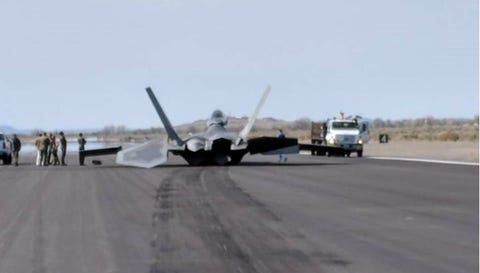Air Force Releases Explanation for April's F-22 Belly Flop Accident
The pilot was provided with incorrect data for takeoff.
By Kyle Mizokami GETTY IMAGES/NURPHOTO
GETTY IMAGES/NURPHOTOBack in a April, one of the U.S. Air Force's F-22 Raptors belly-flopped right after takeoff and skidded down more than a mile of runway. Now the service has revealed what went wrong: the pilots were given the wrong takeoff airspeed.
On April 13 of this year, an F-22 fighter jet took off from Naval Air Station Fallon in Nevada for a TOP GUN exercise. The Raptor pilot, part of the 90th Fighter Squadron at Joint Base Elmendorf-Richardson in Alaska, took off at 120 knots. According to Air Force Times, the F-22 took off going 23 knots slower than the recommended speed—enough to lift the jet off the runway, but not to keep it in the air.

The stricken F-22 at the end of the runway.
AIR FORCE AMN/NCO/SNCO FACEBOOK PAGE.
All aircraft have a minimum takeoff speed, and that number wildly diverges depending on the aircraft’s design and takeoff weight. Local conditions also factor in, including temperature, air density, altitude, and runway slope. As a result, the same jet may have different recommended takeoff speeds on consecutive days.
In this case, not only did the pilot lift off prematurely, but the official recommended liftoff speed was wrong. After the pilot raised the landing gear the jet sunk back down to the ground, skidding 6,514 feet down the runway before coming to a complete stop. The pilot quickly exited the jet unharmed.
Why don’t pilots train to takeoff at a guaranteed safe airspeed? In wartime, airfields will come under attack by enemy bombs and missiles--particularly airfield denial weapons such as the German JP233 (see above). These attacks could shorten the likely useful length of an airfield. Training to operate under combat conditions means using as little runway as possible—with a safe margin of error, of course. In this case a series of mistakes erased that margin of error, and the result was a F-22 Raptor that took its turn as the world’s most expensive toboggan.
The Air Force's Accident Investigation Board also determined the pilot raised the aircraft landing gear prematurely and that the daily brief was inadequate. It also found that “organizational overconfidence in the equipment, formal training is not adequate, and there is an organizational acceptance of an incorrect technique of taking off in the F-22.”
Read more at Air Force Magazine.
No comments:
Post a Comment